There’s a paragraph in my new novel, Fool Her Once where the protagonist’s husband, Zack, has this to say about one of the fictional cops in the story: “There was something smarmy about Brad… a psychopathic vibe he gave off … Zack wasn’t surprised. It was common knowledge that there were certain professions that attracted psychos, just as it was well known that the police force had its fair share.”
I didn’t conjure up the last sentence out of thin air.
As a long-time resident of the East End of Long Island, where FHO is set, I was aware, at the time of writing, that there were plenty of Suffolk County cops who, if not always psychopaths, were liars, thugs, bullies, and lawbreakers.
Police Chief and D.A. Conspiracy
 Corruption permeated the police force from the very top. In 2015, as I was starting on my first draft, James Burke Suffolk County’s police chief was indicted by a grand jury on charges of assaulting a suspect. He was sentenced the following year to 46 months in jail.
Corruption permeated the police force from the very top. In 2015, as I was starting on my first draft, James Burke Suffolk County’s police chief was indicted by a grand jury on charges of assaulting a suspect. He was sentenced the following year to 46 months in jail.
Meanwhile federal investigators also unearthed a coverup of Burke’s assault that involved a widespread net of cops and law enforcement officials. Their investigation led to the indictment, conviction and sentencing of Suffolk County’s top lawman, District Attorney, Tom Spota, as well as his top anti-corruption prosecutor, Christopher McPartland.
Jimmy The King
I got to relive the entire outrageous saga while reading Jimmy the King, the very excellent, detailed non-fiction account of the rise and fall of former police chief Burke.
Author Gus Garcia-Roberts, an investigative journalist, was a member of the Newsday team that published the 2014 Pulitzer Prize-nominated series on police misconduct in Suffolk County. Publishers Weekly rightly credits his “encyclopedic knowledge” and “skilled storytelling” in Jimmy The King.
Sex Toys & Porn In A Duffel Bag

The book starts in 2012 with a witless heroin addict breaking into the SUV of police chief Burke. Not knowing who the SUV belongs to, Christopher Loeb steals a duffel bag containing an ammo belt, a box of cigars, a pornographic DVD and sex toys including dildos. It takes less than 24 hours for Loeb to be found with the stolen property at his mother’s house.
Reconstructing events from state and federal court testimony of two dozen witnesses, Garcia-Roberts recreates, among others, the scene of the police officers at the Loeb house. He writes:
“...via mostly unspoken cop instinct, the cover-up began. Regensburg had already taken one glance at the Viagra prescription pill bottles with James Burke’s name on them in the duffel, and immediately tossed them in the garbage. The dildos and some other items vaporized, either buried unphotographed in the bag or likewise tossed. Then there was the matter of the porn.”
Garcia-Roberts continues: “At least three law enforcement officers … saw firsthand the contents of Burke’s bag. Many others quickly heard the gossip. But they fudged their reports, sanitized their photos, and were prepared to lie under oath, all of it apparently to hide the fact that their chief kept dildos and porn at the ready.”
Later, Burke appears at the precinct where detectives brought Loeb and shackled him to the floor. When Loeb refuses to confess, Burke himself interjects by punching Loeb about the head and body and kneeing him in such fury that fellow police officers have to pull him off Loeb.
Telling The Whole Story

It took FBI agents investigating the assault three years to break through the wall of silence and coverups that stretched all the way to the District Attorney, Tom Spota, and his top aide.
Garcia-Roberts tells the whole tale interweaving it with the history of the nefarious relationship between Burke and Spota which started decades before during an investigation into the murder of a 13-year old boy. Back then, Burke, a teenager emerged as a witness in that investigation (in which Spota was the prosecutor) which railroaded four boys into confessions to a murder they did not commit.
Although something of a juvenile delinquent himself, Burke was accepted into the police force and rose swiftly in the ranks to become police chief. He was supported by a cabal of like-minded cops, and prosecutors like Spota who at one time was the attorney on retainer for the Suffolk County Detectives’ Association.

Garcia-Roberts places the sordid tale of Burke’s rise to power within a much broader context of the ethos and culture of a dirtied police force. One in which Suffolk County’s elite detective unit — aka homicide bulls –for decades trampled on suspects’ rights, and coerced confessions that had prosecutors turning a blind eye. Convictions rarely stood the test of time in appellate courts, but the county’s homicide bulls continued with impunity.
It is a stunning, assiduously-footnoted account in which Garcia-Roberts provides sources chapter by chapter at the end of the book.
Coerced Confessions
The author’s detailed depiction of the decades-long history of cop corruption in Suffolk County shows that Burke, Spota and McPartland were not merely three bad apples. Among other sources, Garcia-Roberts references a 1979 National Law Journal article by Rafael Abramowitz ( with whom I later worked on the TV newsmagazine, A Current Affair.)
In the article, titled “When Suspects Are Abused: Allegations of Beatings, Forced Confessions in a N.Y. Suburb Are Widespread,” Abramowitz detailed more than thirty cases in which suspects alleged they had been tortured or beaten into confessing.
Garcia-Roberts reports further on Abramowitz’s conclusions that,”Suffolk authorities appeared incapable of trying a homicide case without a confession. [Abramowitz] found that twenty-seven of twenty-eight murder indictments in the previous year included a confession. It was a 97 percent rate, much higher than that of neighboring counties. The coerced confessions went hand in hand with the other Suffolk trick, which was to deny defendants access to their attorneys.”
State Investigation
Garcia-Roberts also references a 1989 State Investigation Commission report. The 199-page report based on four years of investigations included damning conclusions about the Suffolk County police force. Garcia-Roberts quotes the report as stating that Suffolk County was a “jurisdiction in which the misconduct was woven into the fabric of the agencies heading up county law enforcement.
“The smoking gun,” the report stated was the “day-in, day-out manner” in which the police and the DA’s office “have conducted the business of law enforcement in Suffolk County so badly.”
Gilgo Beach Murders

Garcia-Roberts brings his 500+page account full circle to the present-day to highlight the Gilgo Beach murders. Between 2010 and 2011, ten bodies were found in the Gilgo Beach vicinity on the Great South Bay of Long Island. They were identified mostly as women who had been working as sex workers at the time of their disappearance. The murders are still unsolved.
Since Burke’s fall from power, numerous newspaper and online articles have been written positing Burke as the serial killer. Those views are mostly based on Burke’s reputation and supposed eye-witness accounts of his consorting with and abuse of sex workers — as well as his refusal to allow FBI profilers to help with the serial killer investigation.
Garcia-Roberts steers clear of such a supposition. Instead, he writes: “Here’s another explanation for how badly the case was handled that is less sexy but supported by far more evidence: the department was simply following a storied tradition of being extremely poor at solving murders, particularly high-profile ones. For a department that never moved completely away from its reputation for solving cases by smacking confessions out of prisoners—and historically held little regard for forensics—the bodies on the peninsula made for a perfect foil.
“If any murder ever cried out to be solved by science, data, and state-of-the-art police methods, and not scraped fists in an interrogation room, this was it.”
Jimmy The King is a fascinating, staggering and eye-opening account of true crimes committed by cops in one of the country’s largest police departments. Garcia-Roberts makes it almost impossible — almost— to wrap one’s head around such breathtaking and widespread arrogance, brutality and dereliction of duty by the very individuals tasked with protecting and serving the residents of Suffolk County.
Jimmy the King was published May 3 by Public Affairs.
.
One thought on “Jimmy The King: A True Crime Classic About The Dirtiest Cops on Long Island”
Comments are closed.